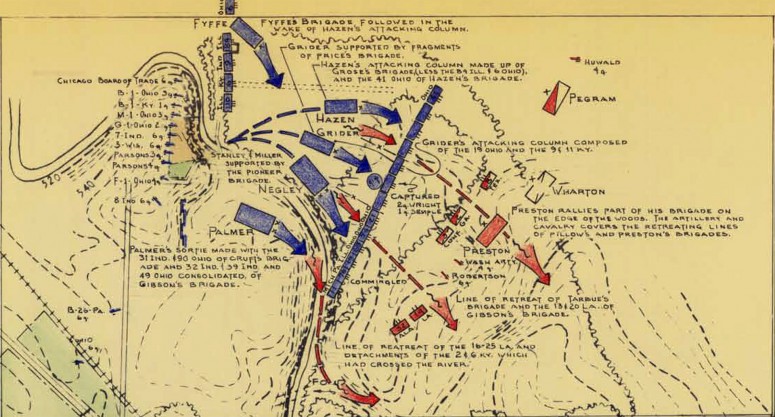The McFadden Farm tour stop is one of the more involving on the Stones River National Battlefield Tour. In addition to the Artillery Monument—one of the few monuments in the park—and the McFadden Family cemetery, there are a number of trail options. None of these hikes are required to understand the events or to access exhibits, but they do give visitors a better understanding of the terrain and how it played a part in the outcome of the fighting on January 2, 1863, the third day of the battle (though only the second day of fighting).
Up until this point in the battlefield tour, Stones River, the battle’s namesake, has not even been mentioned. At McFadden Farm you finally get to see it and learn of its role in the battle. While the Nashville Pike (today’s Old Nashville Highway) and the Nashville & Chattanooga Railroad tracks (CSX tracks today) split the Stones River Battlefield into an eastern and western section, they do so only on a map. It is the Stones River that physically divides the battlefield.
Because placing men on either side of a river effectively splits an army in two, there weren’t many men of either army east of the Stones River at the start of the battle. The Union had no men at all on the east side, but did have men situated along the western shore at the McFadden Farm. The farm sits on a hill high above the river and is sandwiched between the water and the railroad tracks. McFadden’s Ford, a natural river crossing, is just below the farm. Both the high ground and access to the river crossing made this a prime location for Union troops.
Confederate General Braxton Bragg had originally positioned Lieutenant General William Hardee’s Corps on the east side of the river because it had not rained in a while and the river was easy to cross. However, it started raining on December 26th and Bragg was afraid that Hardee would get stranded, so he brought the men back to the west side. This left only Major General John C. Breckinridge’s division on the east side, and most of his men were far south of the McFadden Farm area. Union troops at the farm were kept in check by Confederate pickets who were lined up on the opposite side of the river (a picket is a small number of men whose purpose was to stand watch and warn the main body of the army if the enemy started to make any moves).
Because the Confederates struck first on December 31st and quickly overran the Union right, Rosecrans had to pull the large majority of his men stationed at the farm back across Nashville Pike to help defend it. The Confederate advance was finally halted late in the day. With things now stabilized and even looking good for the Union, during the New Year’s Day lull, Rosecrans sent troops and artillery under the command of Colonel Samuel Beatty (taking command from the injured General Horatio Van Cleve) back to the farm with orders to cross the river and take control of a hill that overlooked McFadden’s Ford and Harker’s Crossing, another river crossing farther downstream. Beatty was able to do so with little resistance.
Union artillery was now positioned perpendicular to Confederate troops on the west side of Stones River, which allowed artillery fire into the Confederate lines instead of at it. When facing an enemy head on, artillery shells can fall short or go over the head of the target. When perpendicular to the enemy, you are shooting into a long line of men, so you really can’t miss. This is called enfiladed fire.
Realizing that Beatty now posed a threat to his right flank, General Bragg ordered Breckinridge’s men to drive him off the hill and to take control of McFadden Farm. Breckinridge was initially resistant to the idea. He knew that Union artillery were positioned at the farm and had complete command of the valley below. Such an attack would be suicidal. However, he carried out the order and began the attack at 4 PM. Bragg hoped that a late afternoon start would prevent Rosecrans from mounting a counterattack—in January it would be dark by 6 PM at the latest.
Breckinridge and his men easily drove Beatty back across the river via McFadden’s Ford, but as they attempted to pursue the men and capture the farm, fifty-eight Union cannon opened up on them, killing or wounding 1,800 men in less than 45 minutes. The Union even managed to mount a counterattack, but Confederate artillery and cavalry halted the pursuit. Thus ended the fighting on January 2nd, and while small skirmishes occurred the next day, for all intents and purposes, the Battle of Stones River was over.
That night Bragg decided to withdraw from Murfreesboro. The sudden slaughter of Breckinridge’s men combined with approaching Union reinforcements convinced him that he could not win. On the evening of January 3rd, the retreat began. Rosecrans made no effort to pursue the Rebels, instead choosing to occupy the town on the 5th.
The Confederates suffered nearly 10,500 casualties (dead, wounded, missing), while the Union suffered 13,200 casualties. About 80,000 total men participated in the fighting, which makes Stones River one of the deadliest battles, percentage-wise, of any Civil War battle.
Previous Tour Stop | Main Battlefield Tour Page
With a few exceptions, use of any photograph on the National Park Planner website requires a paid Royalty Free Editorial Use License or Commercial Use License. See the Photo Usage page for details.
Last updated on March 10, 2020









